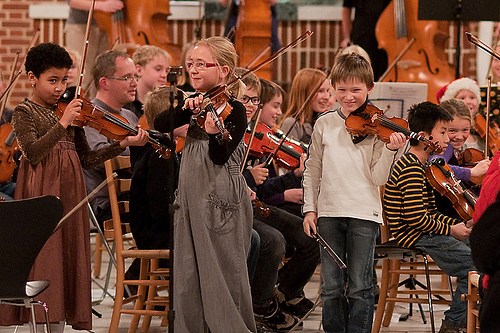Tips & Tricks: Playing in an Orchestra
November 13th, 2012 by Katherine Moller
 This week we just started our orchestras at Park St. Elementary School. It is very exciting for the kids because this is the chance for them to play in a group with different instruments. This made me think of all the things that a person needs to know about playing in a group. Here are six tips for playing in an orchestra.
This week we just started our orchestras at Park St. Elementary School. It is very exciting for the kids because this is the chance for them to play in a group with different instruments. This made me think of all the things that a person needs to know about playing in a group. Here are six tips for playing in an orchestra.
1. Learn your notes at home
When you are in a group, there is nothing that slows rehearsal more than having to wait for someone to learn their notes. As my teachers were fond of saying, practicing (ie. learning your notes) is something you do at home, rehearsal (ie. fitting all the parts together and working on expression) is what you do with the group.
2. Listen to the others around you
The most important thing is to listen to the people around you. It is not enough to play the right notes at the right time. I have described it to my students as being the difference between people playing music in the same room that just happens to fit together and people actually playing music together. You can hear the difference!
3. Listen to recordings of the music
This is actually just plain good advice. If you are playing in an orchestral setting, it is important to become familiar with the music and to be able to pick up auditory cues as to when you need to play your part.
4. Listen to the director/conductor
You need to listen to the director. It is important to listen even if the director is not talking to you as often things that the director says to one group will carry over to others. Also, this is a big time saver if the director does not have to repeat information to each group member individually.
5. Check your ego at the door
Music is a lot like marriage: It is more important to be together than to be right! Even if you are technically playing the passage correctly, but the rest of the group is playing it a different way, don’t play louder to try to convince everyone to play your way, adjust and fit into the group. I have seen this with notes, rhythms and tuning. In the end, even if you are right, if you are the only one doing it, it will look like you are making a mistake.
6. Don’t make excuses
This is a hard one, and I have seen many professional musicians fall into this trap. If the director corrects you or tells you that a note is incorrect, don’t make excuses for why you played it that way, just mark your part and try to fix the problem. If there is a mistake in your printed music (which can happen), just check to make sure that you now have the correct notes, and move on. The director is not making a judgment against you (we tend to take it too personally when we are corrected) he/she is just trying to make the group sound as good as possible!
I hope these tips help! Have a great time playing in a group. It is one of the great joys in music!
photo credit: Niels Linneberg via photopin cc



November 13, 2012 at 3:30 am, thekiddoteacher said:
Tip # 6 is indeed great for teaching kids to be good at something. It’s also a good one for the learner in us. Accepting criticisms positively is an attitude that even adults should practice well.
November 15, 2012 at 3:39 am, Katherine Moller said:
Definitely! As I mentioned, I have seen professionals not accept criticism well, so this is for all of us!